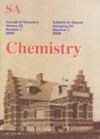在COVID-19大流行期间使用气相色谱-质谱法分析(德班地区)洗手液中的酒精含量
IF 0.8
4区 化学
Q4 CHEMISTRY, MULTIDISCIPLINARY
South African Journal of Chemistry-Suid-Afrikaanse Tydskrif Vir Chemie
Pub Date : 2022-01-01
DOI:10.17159/0379-4350/2022/v76a04
引用次数: 3
摘要
2019冠状病毒病大流行导致对含酒精洗手液(ABHS)的需求空前激增。疾病控制中心(CDC)和世界卫生组织(WHO)建议使用酒精,即异丙醇或乙醇,在ABHS中浓度为60-95%,以获得足够的抗病毒保护。消费者需要警惕销售给公众的不合格洗手液。经常将微生物暴露于低于预防感染建议范围的酒精浓度可能导致耐药突变,高于该范围可能无效。因此,本研究旨在验证洗手液各自标签中所述的酒精含量。我们使用配备Zebron zb蜡毛细管柱的岛津GC-MS-QP2010 Ultra分析了南非夸祖鲁-纳塔尔省德班地区可获得的50份洗手液样本。被分析的洗手液酒精含量在44-93%之间。我们的研究数据还显示,32%(16)的洗手液不符合其标签上注明的酒精含量。16%(8)和12%(6)的ABHS污染物含量<60%,6%(3)的ABHS污染物分别为1-丙醇和乙酸乙酯。这项研究明确强调了制造商利用大流行的情况,以及需要制定更严格的指导方针和法规,以确保ABHS制造商之间的一致性。公众也应该更加警惕洗手液瓶子上的酒精含量(理想范围为60-80%),并注意人们需要相互摩擦双手直到感觉干燥。关键词:醇含量,乙醇,气相色谱-质谱法,洗手液,2-丙醇(异丙醇)本文章由计算机程序翻译,如有差异,请以英文原文为准。
The analysis of alcohol content in hand sanitisers (in the Durban region) using gas chromatography-mass spectrometry during the COVID-19 pandemic
ABSTRACT The COVID-19 pandemic has resulted in an unprecedented surge in the demand for alcohol-based hand sanitisers (ABHS). The Centre for Disease Control (CDC) and World Health Organisation (WHO) recommend alcohol, i.e., isopropanol or ethanol, at a 60-95% concentration in ABHS for sufficient antiviral protection. Consumers need to be vigilant of substandard hand sanitisers being marketed to the public. The frequent exposure of microorganisms to alcohol concentrations below the recommended range for infection prevention may lead to resistant mutations, and above the range may be ineffective. Therefore, this study aimed to verify the stated alcohol content in hand sanitisers from their respective labels. We analysed 50 hand sanitiser samples available to our region in Durban, KwaZulu-Natal, South Africa, using a Shimadzu GC-MS-QP2010 Ultra equipped with a Zebron ZB-wax capillary column. The hand sanitisers analysed had a range of 44-93% alcohol content. The data from our study also revealed that 32% (16) of hand sanitisers did not adhere to the stated alcohol indicated on their labels. 16% (8) contained >80% and 12% (6) contained <60%, while 6% (3) of the ABHS contained 1-propanol and ethyl acetate as contaminants, respectively. This study clearly emphasises manufacturers' exploitation of the pandemic and the need for stricter guidelines and regulations for consistency amongst ABHS manufacturers. The public should also be more alert to the % alcohol stated (ideal range 60-80%) on the sanitizer bottle and note one needs to rub their hands together until it feels dry. Keywords: alcohol-content, ethanol, gas chromatography-mass spectrometry, hand sanitiser, 2-propanol (isopropanol)
求助全文
通过发布文献求助,成功后即可免费获取论文全文。
去求助
来源期刊
CiteScore
3.10
自引率
0.00%
发文量
6
审稿时长
>12 weeks
期刊介绍:
Original work in all branches of chemistry is published in the South African Journal of Chemistry. Contributions in English may take the form of papers, short communications, or critical reviews.

 求助内容:
求助内容: 应助结果提醒方式:
应助结果提醒方式:


